General Livestock Feeding. Classes of Feeds Classifications Classes


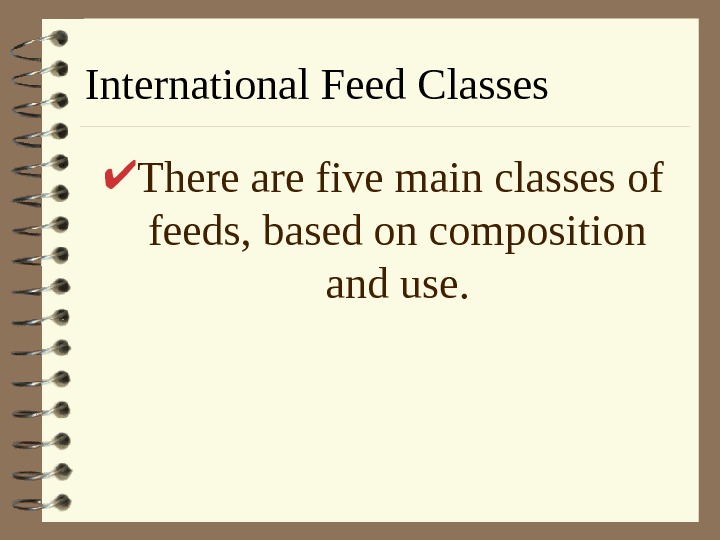





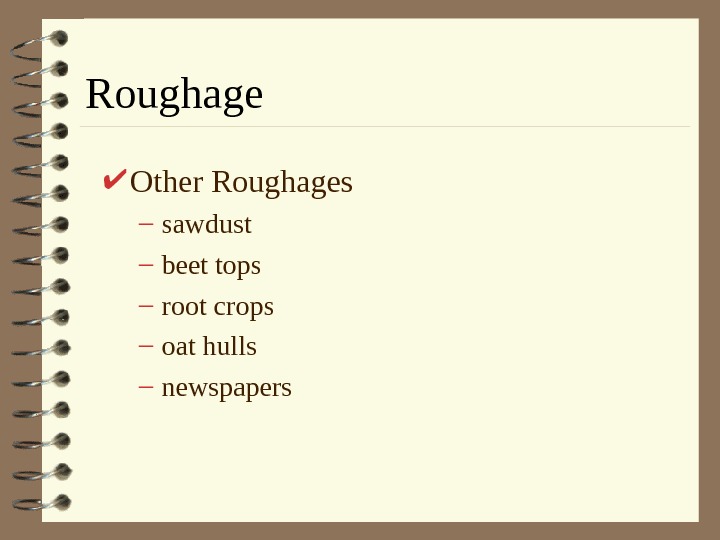

















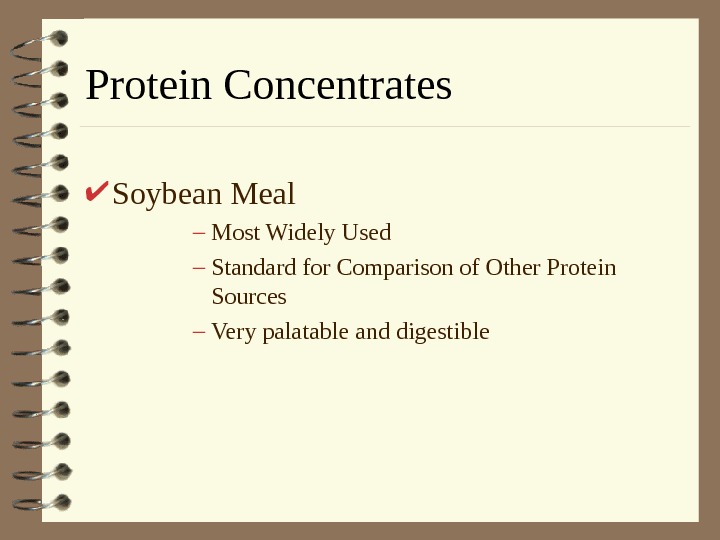



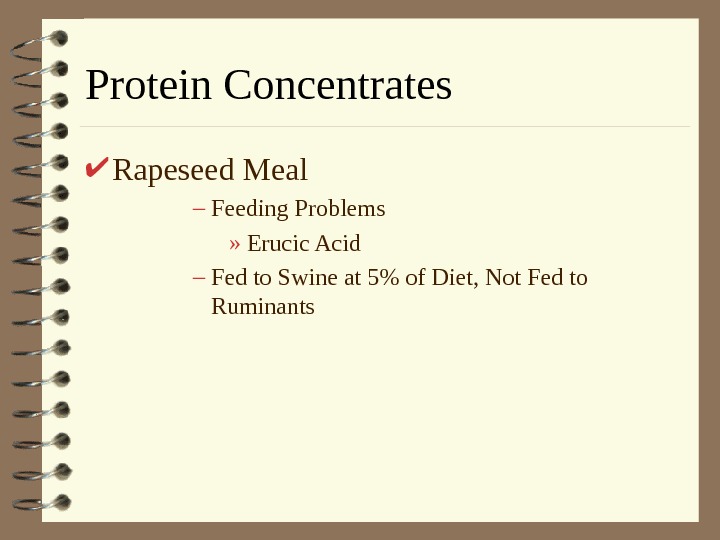






















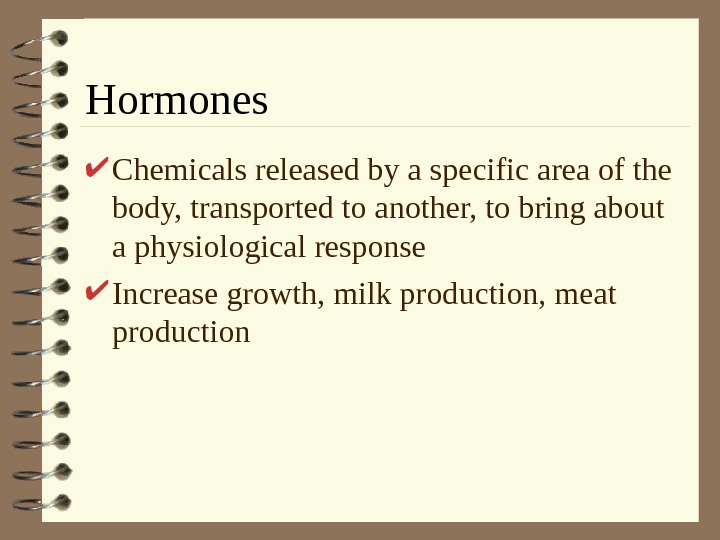
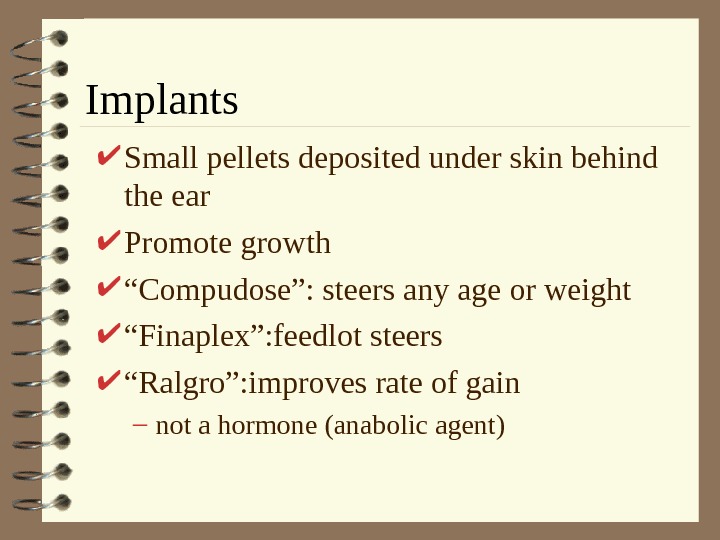

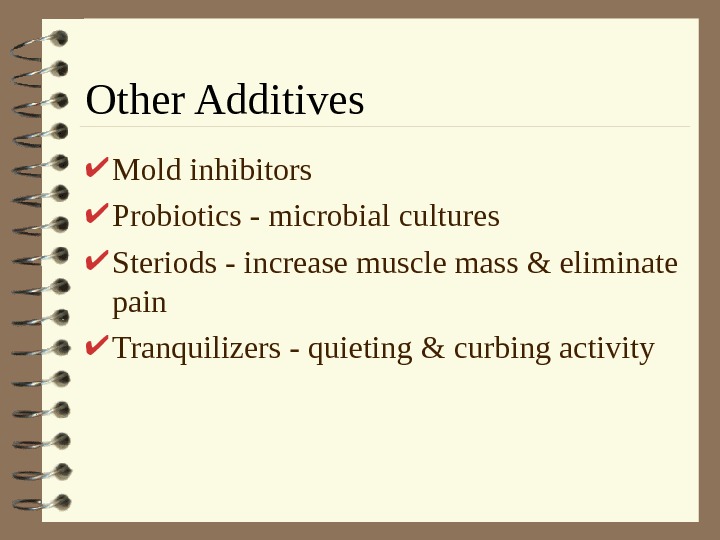
5._general_livestock_feeding._classes.ppt
- Размер: 1.1 Mегабайта
- Количество слайдов: 56
Описание презентации General Livestock Feeding. Classes of Feeds Classifications Classes по слайдам
 General Livestock Feeding. Classes of Feeds Classifications Classes of Feeds, Their Nutritive Characteristics and Scope of Application
General Livestock Feeding. Classes of Feeds Classifications Classes of Feeds, Their Nutritive Characteristics and Scope of Application
 International Feed Classes There are five main classes of feeds, based on composition and use.
International Feed Classes There are five main classes of feeds, based on composition and use.
 Feed Classifications Roughages (Forages) Concentrates — Energy Concentrates — Protein Concentrates Minerals Vitamins Feed Additives
Feed Classifications Roughages (Forages) Concentrates — Energy Concentrates — Protein Concentrates Minerals Vitamins Feed Additives
 1. Roughages Bulky feeds low in weight per unit Contain more than 19% crude fiber in DM Low in Energy Natural feeds of ruminants Generally low in digestibility High in Ca, K, and trace minerals Higher in fat-soluble vitamins Protein varies (from 3% to 22 -23% CP)
1. Roughages Bulky feeds low in weight per unit Contain more than 19% crude fiber in DM Low in Energy Natural feeds of ruminants Generally low in digestibility High in Ca, K, and trace minerals Higher in fat-soluble vitamins Protein varies (from 3% to 22 -23% CP)
 Roughages Pastures Hay – varies more than any other feed – harvest at optimum time – if cured properly, contain 20% moisture or less Crop Residues – left in field after harvest – straw, corn stalks, chaff etc
Roughages Pastures Hay – varies more than any other feed – harvest at optimum time – if cured properly, contain 20% moisture or less Crop Residues – left in field after harvest – straw, corn stalks, chaff etc
 Roughages Silage = fermented forage plants – mostly corn or sorghum – 2 1/2 to 3 kg silage replaces 1 kg hay due to lower dry matter content of silage Haylage = low moisture silage – grass or legume wilted to 40 -60% moisture before ensiling – more dry matter & feed value
Roughages Silage = fermented forage plants – mostly corn or sorghum – 2 1/2 to 3 kg silage replaces 1 kg hay due to lower dry matter content of silage Haylage = low moisture silage – grass or legume wilted to 40 -60% moisture before ensiling – more dry matter & feed value
 Roughage Green Chop (soilage) – fresh plants cut and chopped in the field, transported and fed to animals in confinement – 50% more feed value – extra equipment required – harvest every day
Roughage Green Chop (soilage) – fresh plants cut and chopped in the field, transported and fed to animals in confinement – 50% more feed value – extra equipment required – harvest every day
 Roughage Other Roughages – sawdust – beet tops – root crops – oat hulls – newspapers
Roughage Other Roughages – sawdust – beet tops – root crops – oat hulls – newspapers
 Forages as Energy Sources Forages (roughages) can supply some of the energy needs in the livestock ration, although they are not as concentrated source of energy as the grains. Value of forages for livestock feed is highly dependent on time of harvesting. As forage plants mature, the crude fiber content (cellulose and lignin) increases, which lowers the digestibility of the feed. When forages are harvested as silage, more of the nutritional value of the plant is preserved.
Forages as Energy Sources Forages (roughages) can supply some of the energy needs in the livestock ration, although they are not as concentrated source of energy as the grains. Value of forages for livestock feed is highly dependent on time of harvesting. As forage plants mature, the crude fiber content (cellulose and lignin) increases, which lowers the digestibility of the feed. When forages are harvested as silage, more of the nutritional value of the plant is preserved.
 Corn Silage Corn silage, which contains almost 50% grain on a dry matter basis, is an excellent energy source for certain classes of livestock. Sorghum and small grain silages are lower in energy content than corn silage.
Corn Silage Corn silage, which contains almost 50% grain on a dry matter basis, is an excellent energy source for certain classes of livestock. Sorghum and small grain silages are lower in energy content than corn silage.
 Straws Oat, barley and wheat straws are low in energy value and are not used as a major source of energy. It may be used if additional fiber is needed in the ration.
Straws Oat, barley and wheat straws are low in energy value and are not used as a major source of energy. It may be used if additional fiber is needed in the ration.
 Pastures Properly managed pastures can be a good source of nutrients. Rotating and fertilizing pastures to get the best yield and nutritional value. Quality of pasture must be closely watched and supplemented with good quality stored forages when necessary.
Pastures Properly managed pastures can be a good source of nutrients. Rotating and fertilizing pastures to get the best yield and nutritional value. Quality of pasture must be closely watched and supplemented with good quality stored forages when necessary.
 2. Concentrates Feeds high in energy an low in fiber (under 19%) Highly palatable and eaten rapidly Low volume per unit of weight (high specific gravity)
2. Concentrates Feeds high in energy an low in fiber (under 19%) Highly palatable and eaten rapidly Low volume per unit of weight (high specific gravity)
 Energy Concentrates A major source of energy nutrients is the cereal grains and grain byproduct. These feeds are called energy concentrates or basal feeds when their crude protein is less than 18% in DM.
Energy Concentrates A major source of energy nutrients is the cereal grains and grain byproduct. These feeds are called energy concentrates or basal feeds when their crude protein is less than 18% in DM.
 Corn (Maize) One of the highest energy feeds available. The most widely grown and used feed grain crop. It is an economical and superior source of energy. Consideration must be given to amount to feed, frequency and combinations with other feeds, in order to get the most efficient use of this high energy feed source without causing digestive problems.
Corn (Maize) One of the highest energy feeds available. The most widely grown and used feed grain crop. It is an economical and superior source of energy. Consideration must be given to amount to feed, frequency and combinations with other feeds, in order to get the most efficient use of this high energy feed source without causing digestive problems.
 Corn & Cob Meal Contains about 10% less energy than shelled corn because of the fiber content in the cob. All species can utilize it, however, when feed to growing-fattening hogs because they do not have the ability to digest and use much of the cob content.
Corn & Cob Meal Contains about 10% less energy than shelled corn because of the fiber content in the cob. All species can utilize it, however, when feed to growing-fattening hogs because they do not have the ability to digest and use much of the cob content.
 Oats About 85% of the energy of corn. Higher in crude protein than corn and add fiber and bulk to the ration. Help the rumen maintain bacterial and protozoa function. Not a good fattening feed but are used extensively in rations for horses, young growing stock, breeding animals. Usually fed rolled or ground.
Oats About 85% of the energy of corn. Higher in crude protein than corn and add fiber and bulk to the ration. Help the rumen maintain bacterial and protozoa function. Not a good fattening feed but are used extensively in rations for horses, young growing stock, breeding animals. Usually fed rolled or ground.
 Barley Almost equal to corn in energy value, but lies between corn and oats in fiber content. Used in a ration in a manner similar to oats. Barley may replace up to 50 % of the corn in rations for fattening animals. To improve palatability it is often steam rolled
Barley Almost equal to corn in energy value, but lies between corn and oats in fiber content. Used in a ration in a manner similar to oats. Barley may replace up to 50 % of the corn in rations for fattening animals. To improve palatability it is often steam rolled
 Wheat High in both energy and protein. Wheat is similar to corn in composition and feeding value. If and when it is used in a ration it is included at low levels in a mix with other grains because it is rapidly digested and may cause digestive disturbances.
Wheat High in both energy and protein. Wheat is similar to corn in composition and feeding value. If and when it is used in a ration it is included at low levels in a mix with other grains because it is rapidly digested and may cause digestive disturbances.
 Grain Sorghum There are many varieties and various hybrids. Smaller than corn and may replace up to 100% of the corn in a feedlot ration. Generally rolled or ground when included in a ration.
Grain Sorghum There are many varieties and various hybrids. Smaller than corn and may replace up to 100% of the corn in a feedlot ration. Generally rolled or ground when included in a ration.
 Rye is usually used for bread for human consumption and has limited use as a livestock feed. It is not as valuable as corn, whet or grain sorghum. Ergot contaminated rye can be toxic to livestock. The use of rye in livestock rations should be limited to no more than one-third of the ration. It should be coarsely ground or rolled to increase palatability.
Rye is usually used for bread for human consumption and has limited use as a livestock feed. It is not as valuable as corn, whet or grain sorghum. Ergot contaminated rye can be toxic to livestock. The use of rye in livestock rations should be limited to no more than one-third of the ration. It should be coarsely ground or rolled to increase palatability.
 Peas By 10% less energy value then that of corn. Significantly higher in crude protein than corn (up to 20% CP per 1 kg). A good source of protein and lysine. But includes some undesirable factors, which may cause digestive disturbances. Better to use after heat treatment (extrusion)
Peas By 10% less energy value then that of corn. Significantly higher in crude protein than corn (up to 20% CP per 1 kg). A good source of protein and lysine. But includes some undesirable factors, which may cause digestive disturbances. Better to use after heat treatment (extrusion)
 Sources of Energy—Fats & Oils A byproduct of oil and packing plants, poultry processing plants. Fats and oils in the feed reduces the dustiness of the feed. A highly concentrated source of energy (at least 300% of corn energy value) I ncreases calorie density of a ration (2, 25 times energy of carbohydrates) Often treated with antioxidants to prevent the feed from becoming rancid in storage. Beef and dairy rations can contain up to 5% while swine rations may have up to 20%.
Sources of Energy—Fats & Oils A byproduct of oil and packing plants, poultry processing plants. Fats and oils in the feed reduces the dustiness of the feed. A highly concentrated source of energy (at least 300% of corn energy value) I ncreases calorie density of a ration (2, 25 times energy of carbohydrates) Often treated with antioxidants to prevent the feed from becoming rancid in storage. Beef and dairy rations can contain up to 5% while swine rations may have up to 20%.
 Sources of Energy—Molasses By-product of sugar manufacture Common types of molasses are cane, beet, citrus and wood. ¾ energy value of corn Molasses is used in rations for cattle, sheep and horses but is seldom used in swine rations, because it causes scouring. Appetizer, improves palatability, aids rumen microbial activity, reduces dust and serves as a binder when feeds are pelleted. Molasses is usually limited to not more than 10 -15% of the ration.
Sources of Energy—Molasses By-product of sugar manufacture Common types of molasses are cane, beet, citrus and wood. ¾ energy value of corn Molasses is used in rations for cattle, sheep and horses but is seldom used in swine rations, because it causes scouring. Appetizer, improves palatability, aids rumen microbial activity, reduces dust and serves as a binder when feeds are pelleted. Molasses is usually limited to not more than 10 -15% of the ration.
 Protein Concentrates Protein Supplements – Plant Origin (Oil By-Products: Meals and Cakes ) • Expeller or Hydraulic Process — Crushed, Heated, Pressed, Ground = Cakes – 5% residual oil remains in cake • Solvent — Cracked, Heated, Rolled, Extracted with Hexane and Flakes Toasted and Ground = Meals – 1% residual oil remains in meal
Protein Concentrates Protein Supplements – Plant Origin (Oil By-Products: Meals and Cakes ) • Expeller or Hydraulic Process — Crushed, Heated, Pressed, Ground = Cakes – 5% residual oil remains in cake • Solvent — Cracked, Heated, Rolled, Extracted with Hexane and Flakes Toasted and Ground = Meals – 1% residual oil remains in meal
 Protein Concentrates Soybean Meal – Most Widely Used – Standard for Comparison of Other Protein Sources – Very palatable and digestible
Protein Concentrates Soybean Meal – Most Widely Used – Standard for Comparison of Other Protein Sources – Very palatable and digestible
 Protein Concentrates Soybean Meal • 44% CP = standard meal – soybean meal plus 5% soy hulls – used for ruminants, horses, older swine • 48% CP= high protein meal – soybean meal – no soy hulls, very refined – higher protein, lysine – lower fiber – used for baby pigs and poultry
Protein Concentrates Soybean Meal • 44% CP = standard meal – soybean meal plus 5% soy hulls – used for ruminants, horses, older swine • 48% CP= high protein meal – soybean meal – no soy hulls, very refined – higher protein, lysine – lower fiber – used for baby pigs and poultry
 Protein Concentrates Sunflower Meals and Cakes – Protein varies with Process Used » 28, 32, 38 or 40% – Can Replace 30 -50% of SBM in Swine Diets – Ruminants Can Use as a Sole Protein Supplement
Protein Concentrates Sunflower Meals and Cakes – Protein varies with Process Used » 28, 32, 38 or 40% – Can Replace 30 -50% of SBM in Swine Diets – Ruminants Can Use as a Sole Protein Supplement
 Protein Concentrates Linseed meal – Mechanically extracted – Contains residual oil – Popular among horse owners and show animal feeders because of hair coat Peanut meal – 50% CP
Protein Concentrates Linseed meal – Mechanically extracted – Contains residual oil – Popular among horse owners and show animal feeders because of hair coat Peanut meal – 50% CP
 Protein Concentrates Rapeseed Meal – Feeding Problems » Erucic Acid – Fed to Swine at 5% of Diet, Not Fed to Ruminants
Protein Concentrates Rapeseed Meal – Feeding Problems » Erucic Acid – Fed to Swine at 5% of Diet, Not Fed to Ruminants
 Distiller’s Byproduct Feeds Produced by the Fermentation of Grains (normally corn) for Alcohol Production Generally fed wet Concentrates Produced – Distiller’s Dried Grains — Dried Grain Fraction. – Distiller’s Dried Solubles — Condensing the Thin Stillage Fraction and Drying it.
Distiller’s Byproduct Feeds Produced by the Fermentation of Grains (normally corn) for Alcohol Production Generally fed wet Concentrates Produced – Distiller’s Dried Grains — Dried Grain Fraction. – Distiller’s Dried Solubles — Condensing the Thin Stillage Fraction and Drying it.
 Brewery By-Products as a Result of the Brewing Industry – Feed Products • Brewer’s Dried Grains — Dried Residue from Malting Process.
Brewery By-Products as a Result of the Brewing Industry – Feed Products • Brewer’s Dried Grains — Dried Residue from Malting Process.
 Protein Concentrates Protein Supplements – Animal and Marine Origin • Derived from Meat or Poultry Packing Plants, Rendering Plants, Surplus Milk or Milk By-Products, Marine Sources • Added to Improve Mixture – Rich in CP, lysine and other AA – Low in Sulfur and Tryptophan
Protein Concentrates Protein Supplements – Animal and Marine Origin • Derived from Meat or Poultry Packing Plants, Rendering Plants, Surplus Milk or Milk By-Products, Marine Sources • Added to Improve Mixture – Rich in CP, lysine and other AA – Low in Sulfur and Tryptophan
 Protein Concentrates Protein Supplements – Tankage – By-Product from Meat Packing or Rendering – Unusable Animal Tissue (Bones, Gut, Tendons, Connective Tissue, Blood Meal) – If it Contains a Minimum 4, 4% P it’s called Meat and Bone Tankage – No Hair, Horns, Manure, Gut Contents or Hide
Protein Concentrates Protein Supplements – Tankage – By-Product from Meat Packing or Rendering – Unusable Animal Tissue (Bones, Gut, Tendons, Connective Tissue, Blood Meal) – If it Contains a Minimum 4, 4% P it’s called Meat and Bone Tankage – No Hair, Horns, Manure, Gut Contents or Hide
 Protein Concentrates Protein Supplements – Blood Meal (90% CP): excellent amino acid balance – Meat Meal (50 — 60% CP) – Contains Less Gut, Tendons and Connective Tissue than Tankage – Normally no Blood Meal – If 4, 4% P it’s called Meat and Bone Meal
Protein Concentrates Protein Supplements – Blood Meal (90% CP): excellent amino acid balance – Meat Meal (50 — 60% CP) – Contains Less Gut, Tendons and Connective Tissue than Tankage – Normally no Blood Meal – If 4, 4% P it’s called Meat and Bone Meal
 Protein Concentrates Protein Supplements – Poultry By-Product Meal » Contains Heads, Feet, Intestines, Undeveloped Eggs » No Feathers
Protein Concentrates Protein Supplements – Poultry By-Product Meal » Contains Heads, Feet, Intestines, Undeveloped Eggs » No Feathers
 Protein Concentrates Protein Supplements – Poultry By-Products – Feather Meal » 85% CP (75% digestible protein) » No more than 3% of swine diets
Protein Concentrates Protein Supplements – Poultry By-Products – Feather Meal » 85% CP (75% digestible protein) » No more than 3% of swine diets
 Protein Concentrates Protein Supplements – Fish Meal – Whole fish, fish cuttings; with or without oil – 66% CP, 6% Ca and 3, 5% P – exceptional source of essential amino acids – contains “amines” which cause fishy smell in poultry or swine fed fish meal immediately prior to harvest as well as laying hens
Protein Concentrates Protein Supplements – Fish Meal – Whole fish, fish cuttings; with or without oil – 66% CP, 6% Ca and 3, 5% P – exceptional source of essential amino acids – contains “amines” which cause fishy smell in poultry or swine fed fish meal immediately prior to harvest as well as laying hens
 Protein Concentrates Protein Supplements – Shrimp meal, crab meal, etc. – Exoskeleton contains “chitin” a cellulose-like polysaccharide that is very poorly digested – Protein content derived from meat residue
Protein Concentrates Protein Supplements – Shrimp meal, crab meal, etc. – Exoskeleton contains “chitin” a cellulose-like polysaccharide that is very poorly digested – Protein content derived from meat residue
 Protein Concentrates Protein Supplements – Animal Waste – Used Primarily in Ruminant Diets – Normally Broiler Litter (31% CP, 17% CF, 15% Ash) – 10 -60% of the Protein Exists as NPN
Protein Concentrates Protein Supplements – Animal Waste – Used Primarily in Ruminant Diets – Normally Broiler Litter (31% CP, 17% CF, 15% Ash) – 10 -60% of the Protein Exists as NPN
 Protein Concentrates Protein Supplements – Non-protein Nitrogen products • Urea – Requires readily available carbohydrate source to provide carbon chains for microbial protein synthesis – Rapidly degraded in rumen – May require adaptation period – Maximum levels established due to toxicity problems
Protein Concentrates Protein Supplements – Non-protein Nitrogen products • Urea – Requires readily available carbohydrate source to provide carbon chains for microbial protein synthesis – Rapidly degraded in rumen – May require adaptation period – Maximum levels established due to toxicity problems
 Protein Concentrates Protein Supplements – Milk By-Products • Whey – Wet » By-Product of Cheese Manufacturing – Dried » 11% CP, 61% Lactose
Protein Concentrates Protein Supplements – Milk By-Products • Whey – Wet » By-Product of Cheese Manufacturing – Dried » 11% CP, 61% Lactose
 Protein Concentrates Protein Supplements – Milk By-Products • Dried Whole Milk • Dried Skim Milk • Dried Buttermilk
Protein Concentrates Protein Supplements – Milk By-Products • Dried Whole Milk • Dried Skim Milk • Dried Buttermilk
 Special Feeds of Animal Origin Colostrum: first milk given by mammals after parturition – contains antibodies – within 15 min to 4 hours – surplus colostrum can be frozen for up to a year or more – can feed cow colostrum to lambs etc. , but some diseases are species specific
Special Feeds of Animal Origin Colostrum: first milk given by mammals after parturition – contains antibodies – within 15 min to 4 hours – surplus colostrum can be frozen for up to a year or more – can feed cow colostrum to lambs etc. , but some diseases are species specific
 Special Feeds of Animal Origin Milk Replacers – can’t replace colostrum – a good replacer should contain up to 20% dried milk – fortified with vitamins, minerals & antibiotics – can be used as whole milk diet alternative in rearing programs
Special Feeds of Animal Origin Milk Replacers – can’t replace colostrum – a good replacer should contain up to 20% dried milk – fortified with vitamins, minerals & antibiotics – can be used as whole milk diet alternative in rearing programs
 Feed Additives 80% of farm animals get some drug during lifetime chemicals that regulate growth, modify rumen activity, improve feed efficiency lower production costs unsafe if used improperly
Feed Additives 80% of farm animals get some drug during lifetime chemicals that regulate growth, modify rumen activity, improve feed efficiency lower production costs unsafe if used improperly
 Feed Additives Abortifacients = induces abortion – feedlot heifers Antibiotics = produced by living organisms, bacteriostatic properties – growth stimulators – better feed efficiency
Feed Additives Abortifacients = induces abortion – feedlot heifers Antibiotics = produced by living organisms, bacteriostatic properties – growth stimulators – better feed efficiency
 Antibiotics Low levels in feeds High (therapeutic) levels in feeds
Antibiotics Low levels in feeds High (therapeutic) levels in feeds
 Antioxidants Prevent oxidative rancidity of fats Other methods: – refrigeration – lack of light – lack of oxygen
Antioxidants Prevent oxidative rancidity of fats Other methods: – refrigeration – lack of light – lack of oxygen
 Chemotherapeutics Similar to antibiotics produced chemically instead of biologically
Chemotherapeutics Similar to antibiotics produced chemically instead of biologically
 Electrolytes Substance when disolved in water enables solution to conduct electric current Salts (saline) Replenish fluids lost from: – dehydration (heat stress, birth) – diarrhea – hemorrhage – vomiting
Electrolytes Substance when disolved in water enables solution to conduct electric current Salts (saline) Replenish fluids lost from: – dehydration (heat stress, birth) – diarrhea – hemorrhage – vomiting
 Flavouring Agents Increase palatability & feed intake Many additives taste or smell bad
Flavouring Agents Increase palatability & feed intake Many additives taste or smell bad
 Hormones Chemicals released by a specific area of the body, transported to another, to bring about a physiological response Increase growth, milk production, meat production
Hormones Chemicals released by a specific area of the body, transported to another, to bring about a physiological response Increase growth, milk production, meat production
 Implants Small pellets deposited under skin behind the ear Promote growth “ Compudose”: steers any age or weight “ Finaplex”: feedlot steers “ Ralgro”: improves rate of gain – not a hormone (anabolic agent)
Implants Small pellets deposited under skin behind the ear Promote growth “ Compudose”: steers any age or weight “ Finaplex”: feedlot steers “ Ralgro”: improves rate of gain – not a hormone (anabolic agent)
 Ionophores Feed additives that change the metabolism within the rumen by altering the rumen microorganisms “ Bovatec” & “Rumensin” Lower feed intake, gain same
Ionophores Feed additives that change the metabolism within the rumen by altering the rumen microorganisms “ Bovatec” & “Rumensin” Lower feed intake, gain same
 Other Additives Mold inhibitors Probiotics — microbial cultures Steriods — increase muscle mass & eliminate pain Tranquilizers — quieting & curbing activity
Other Additives Mold inhibitors Probiotics — microbial cultures Steriods — increase muscle mass & eliminate pain Tranquilizers — quieting & curbing activity

